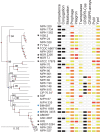The genomic diversification of the whole Acinetobacter genus: origins, mechanisms, and consequences
- PMID: 25313016
- PMCID: PMC4224351
- DOI: 10.1093/gbe/evu225
The genomic diversification of the whole Acinetobacter genus: origins, mechanisms, and consequences
Abstract
Bacterial genomics has greatly expanded our understanding of microdiversification patterns within a species, but analyses at higher taxonomical levels are necessary to understand and predict the independent rise of pathogens in a genus. We have sampled, sequenced, and assessed the diversity of genomes of validly named and tentative species of the Acinetobacter genus, a clade including major nosocomial pathogens and biotechnologically important species. We inferred a robust global phylogeny and delimited several new putative species. The genus is very ancient and extremely diverse: Genomes of highly divergent species share more orthologs than certain strains within a species. We systematically characterized elements and mechanisms driving genome diversification, such as conjugative elements, insertion sequences, and natural transformation. We found many error-prone polymerases that may play a role in resistance to toxins, antibiotics, and in the generation of genetic variation. Surprisingly, temperate phages, poorly studied in Acinetobacter, were found to account for a significant fraction of most genomes. Accordingly, many genomes encode clustered regularly interspaced short palindromic repeats (CRISPR)-Cas systems with some of the largest CRISPR-arrays found so far in bacteria. Integrons are strongly overrepresented in Acinetobacter baumannii, which correlates with its frequent resistance to antibiotics. Our data suggest that A. baumannii arose from an ancient population bottleneck followed by population expansion under strong purifying selection. The outstanding diversification of the species occurred largely by horizontal transfer, including some allelic recombination, at specific hotspots preferentially located close to the replication terminus. Our work sets a quantitative basis to understand the diversification of Acinetobacter into emerging resistant and versatile pathogens.
Keywords: bacterial genus; comparative genomics; evolution; mobile genetic elements; nosocomial pathogens.
© The Author(s) 2014. Published by Oxford University Press on behalf of the Society for Molecular Biology and Evolution.
Figures










Similar articles
-
Pangenome of Acinetobacter baumannii uncovers two groups of genomes, one of them with genes involved in CRISPR/Cas defence systems associated with the absence of plasmids and exclusive genes for biofilm formation.Microb Genom. 2019 Nov;5(11):e000309. doi: 10.1099/mgen.0.000309. Microb Genom. 2019. PMID: 31626589 Free PMC article.
-
Survey of clustered regularly interspaced short palindromic repeats and their associated Cas proteins (CRISPR/Cas) systems in multiple sequenced strains of Klebsiella pneumoniae.BMC Res Notes. 2015 Aug 4;8:332. doi: 10.1186/s13104-015-1285-7. BMC Res Notes. 2015. PMID: 26238567 Free PMC article.
-
Evolution of a pathogen: a comparative genomics analysis identifies a genetic pathway to pathogenesis in Acinetobacter.PLoS One. 2013;8(1):e54287. doi: 10.1371/journal.pone.0054287. Epub 2013 Jan 24. PLoS One. 2013. PMID: 23365658 Free PMC article.
-
[Why so rare if so essentiel: the determinants of the sparse distribution of CRISPR-Cas systems in bacterial genomes].Biol Aujourdhui. 2017;211(4):255-264. doi: 10.1051/jbio/2018005. Epub 2018 Jun 29. Biol Aujourdhui. 2017. PMID: 29956652 Review. French.
-
What do we know about plasmids carried by members of the Acinetobacter genus?World J Microbiol Biotechnol. 2020 Jul 13;36(8):109. doi: 10.1007/s11274-020-02890-7. World J Microbiol Biotechnol. 2020. PMID: 32656745 Review.
Cited by
-
1,2,4-Triazolidine-3-thiones Have Specific Activity against Acinetobacter baumannii among Common Nosocomial Pathogens.ACS Infect Dis. 2017 Jan 13;3(1):62-71. doi: 10.1021/acsinfecdis.6b00133. Epub 2016 Nov 3. ACS Infect Dis. 2017. PMID: 27764938 Free PMC article.
-
Genomic and phenotypic characterization of the species Acinetobacter venetianus.Sci Rep. 2016 Feb 23;6:21985. doi: 10.1038/srep21985. Sci Rep. 2016. PMID: 26902269 Free PMC article.
-
Multidrug Resistant Acinetobacter Isolates Release Resistance Determinants Through Contact-Dependent Killing and Bacteriophage Lysis.Front Microbiol. 2020 Aug 14;11:1918. doi: 10.3389/fmicb.2020.01918. eCollection 2020. Front Microbiol. 2020. PMID: 32922376 Free PMC article.
-
GigC, a LysR Family Transcription Regulator, Is Required for Cysteine Metabolism and Virulence in Acinetobacter baumannii.Infect Immun. 2020 Dec 15;89(1):e00180-20. doi: 10.1128/IAI.00180-20. Print 2020 Dec 15. Infect Immun. 2020. PMID: 33077621 Free PMC article.
-
Genomic plasticity and adaptive capacity of the quaternary alkyl-ammonium compound and copper tolerant Acinetobacter bohemicus strain QAC-21b isolated from pig manure.Antonie Van Leeuwenhoek. 2023 Apr;116(4):327-342. doi: 10.1007/s10482-022-01805-w. Epub 2023 Jan 16. Antonie Van Leeuwenhoek. 2023. PMID: 36642771 Free PMC article.
References
-
- Ackermann HW, Brochu G, Emadi Konjin HP. Classification of Acinetobacter phages. Arch Virol. 1994;135:345–354. - PubMed
-
- Alvarez-Perez S, Lievens B, Jacquemyn H, Herrera CM. Acinetobacter nectaris sp. nov. and Acinetobacter boissieri sp. nov., isolated from floral nectar of wild Mediterranean insect-pollinated plants. Int J Syst Evol Microbiol. 2013;63:1532–1539. - PubMed
Publication types
MeSH terms
Grants and funding
LinkOut - more resources
Full Text Sources
Other Literature Sources
Molecular Biology Databases

